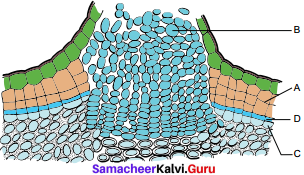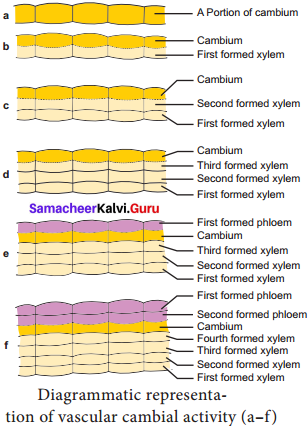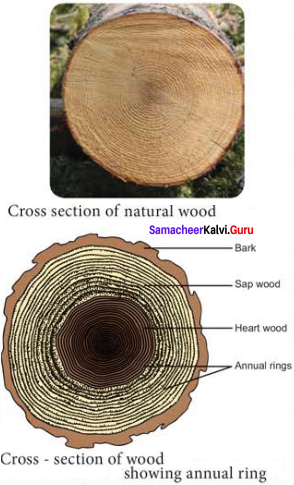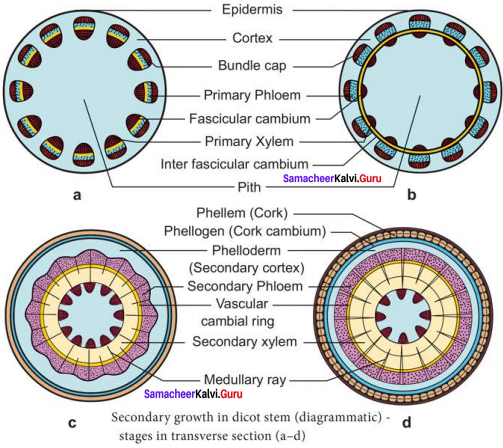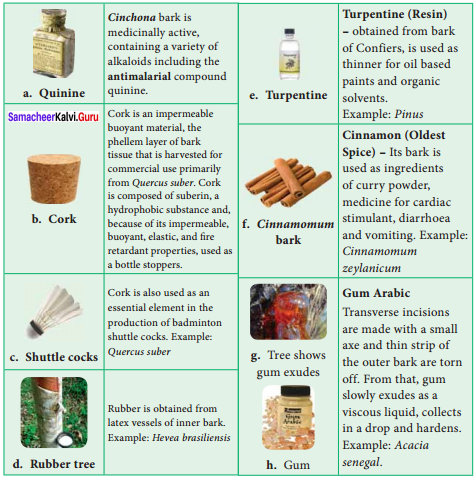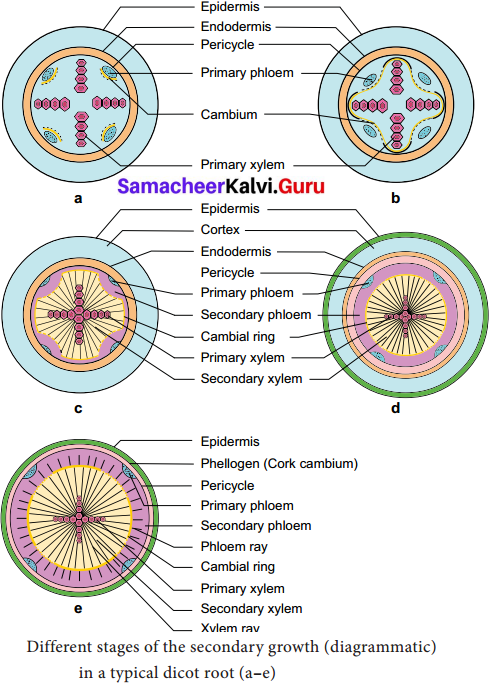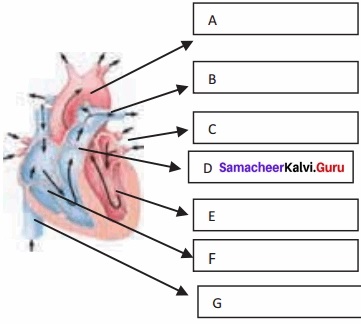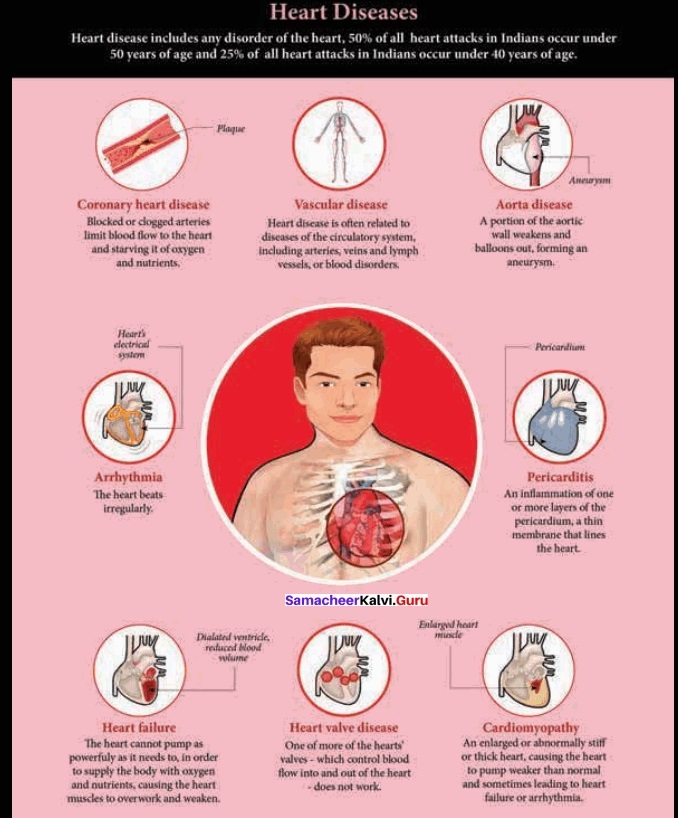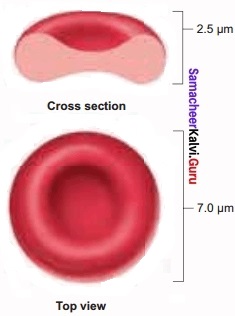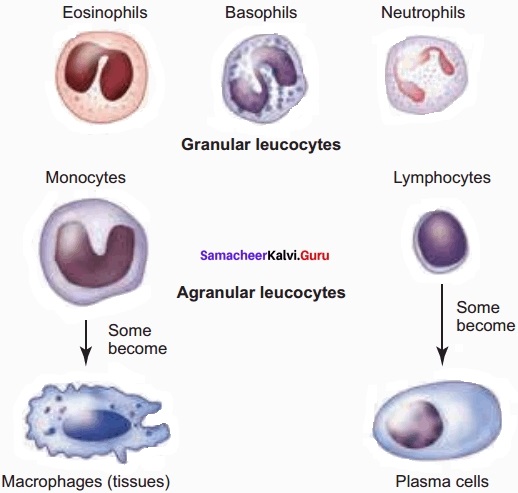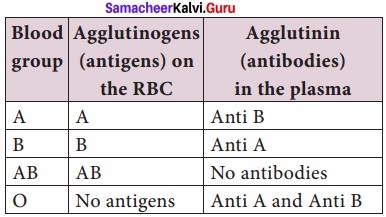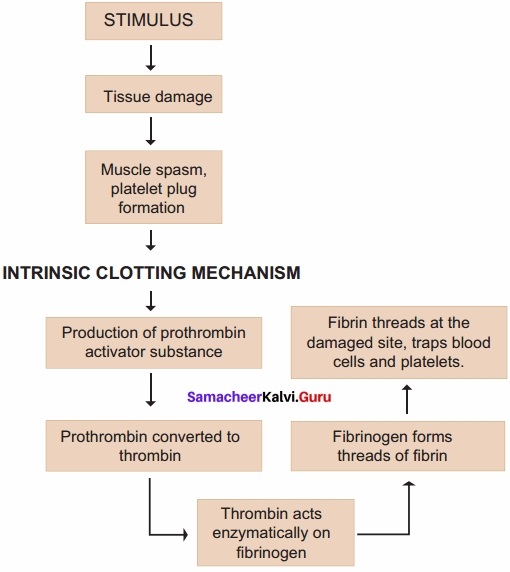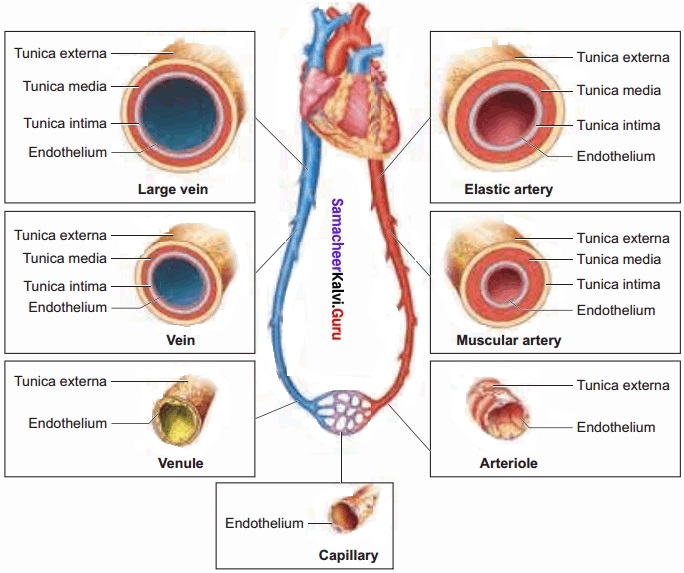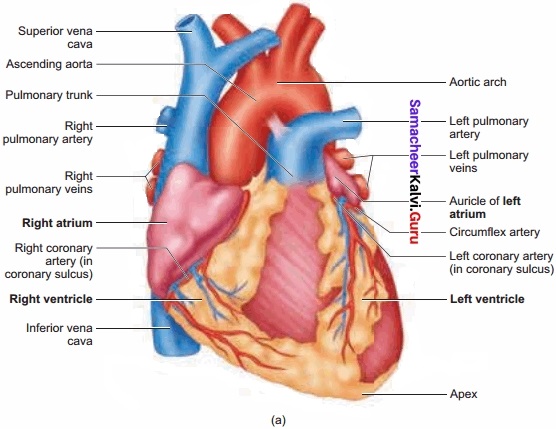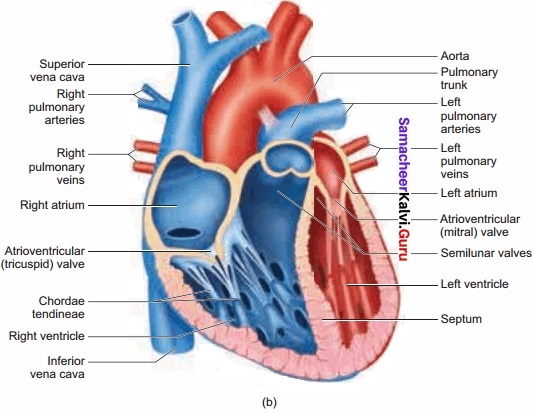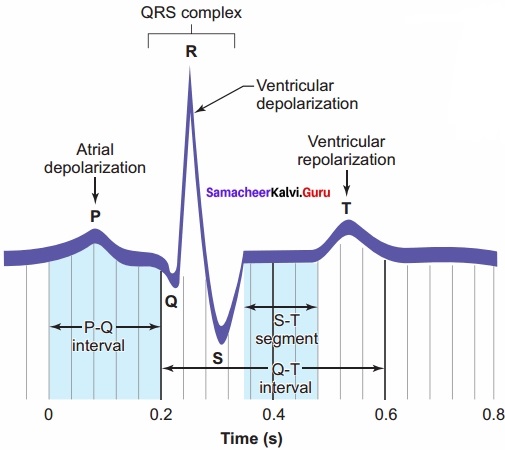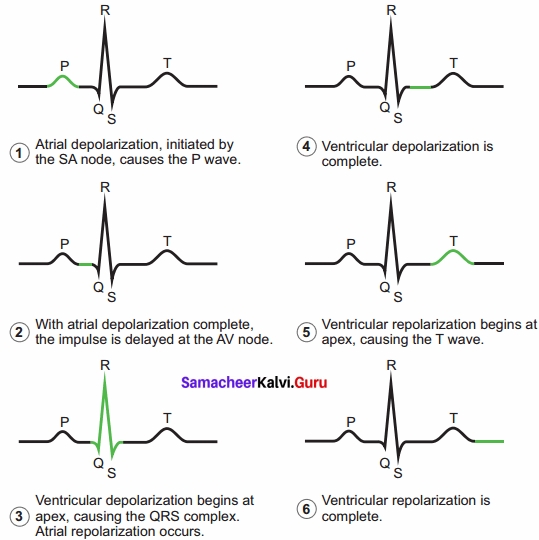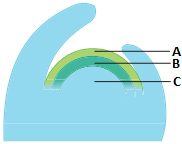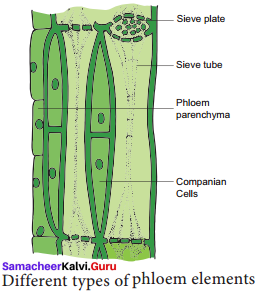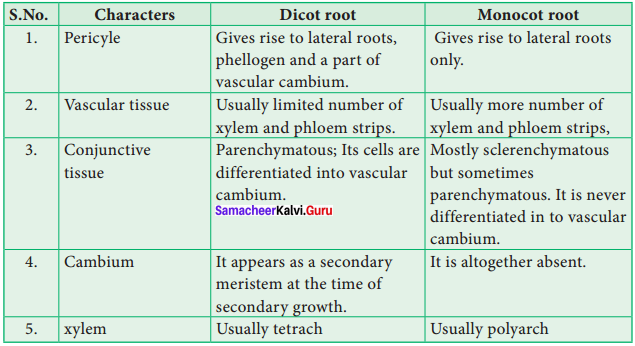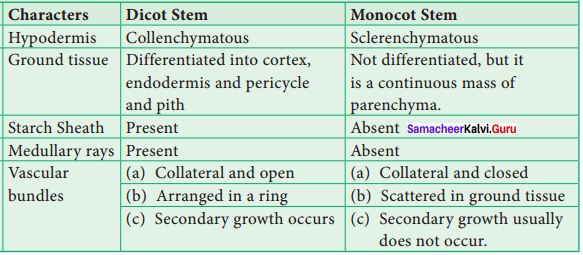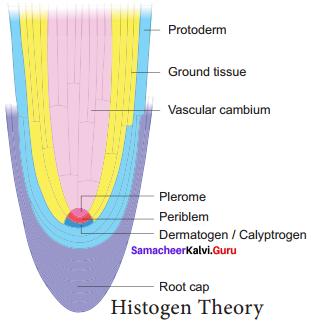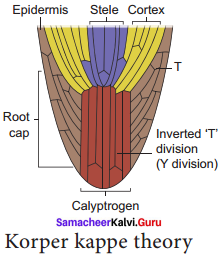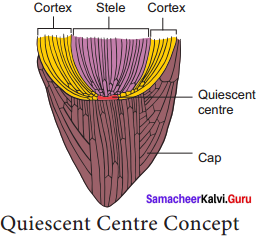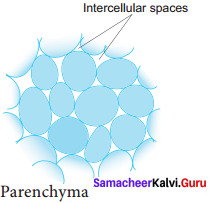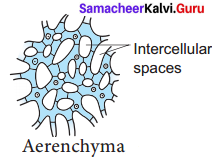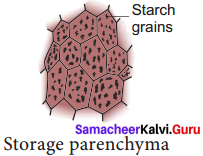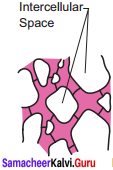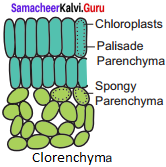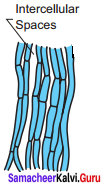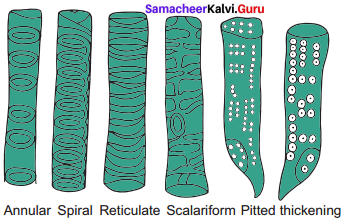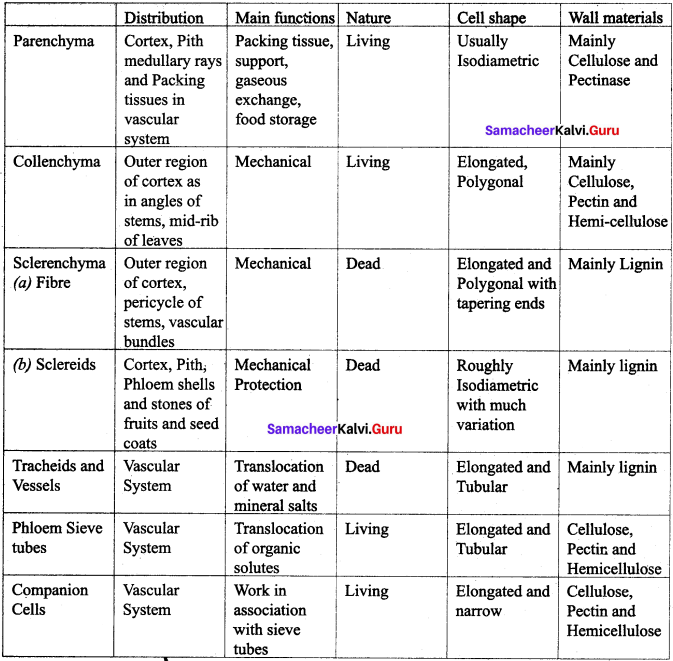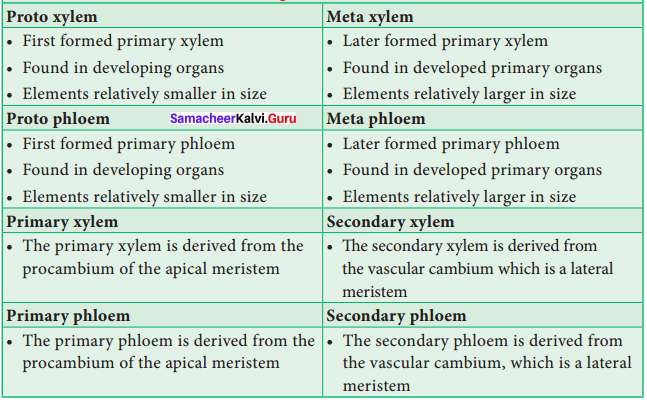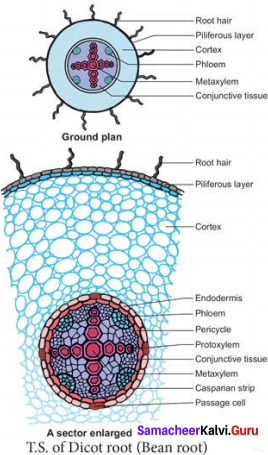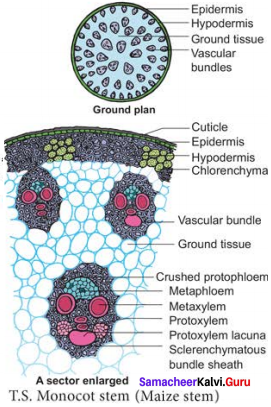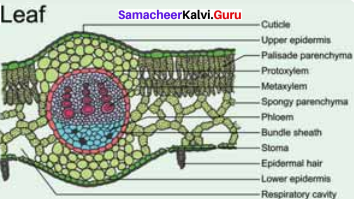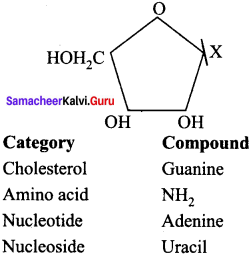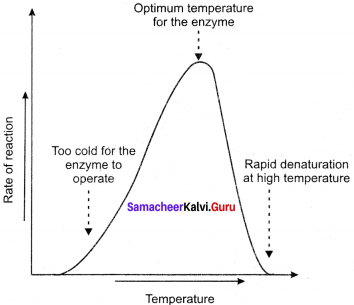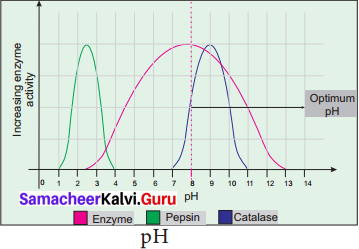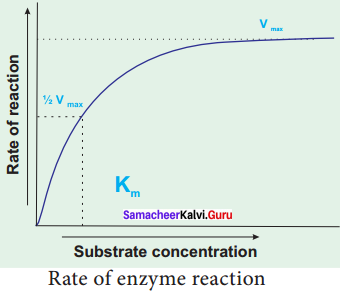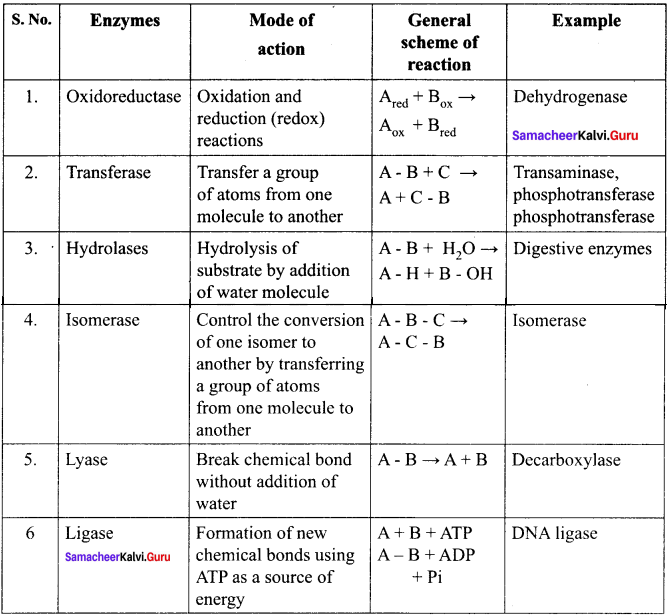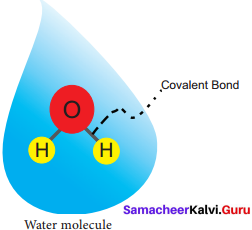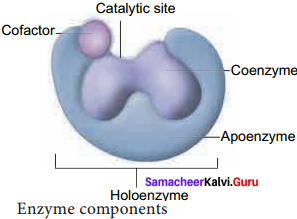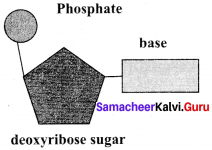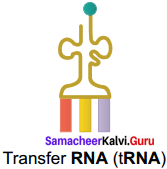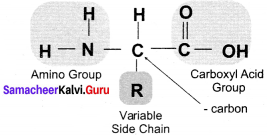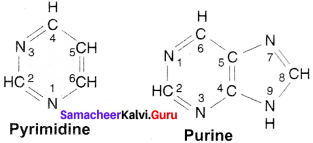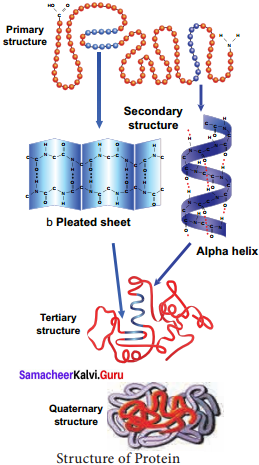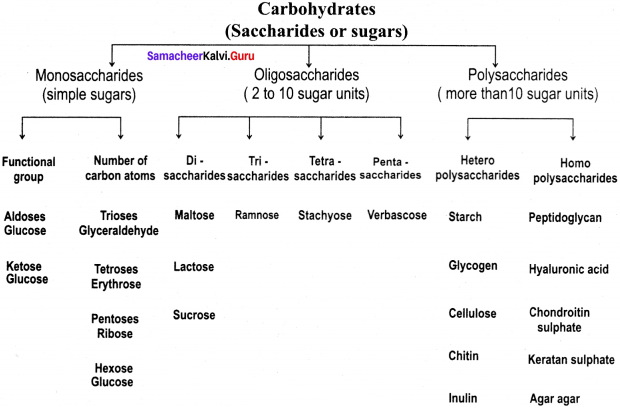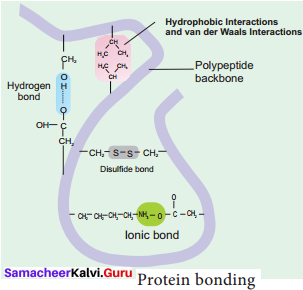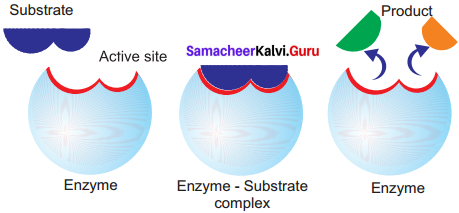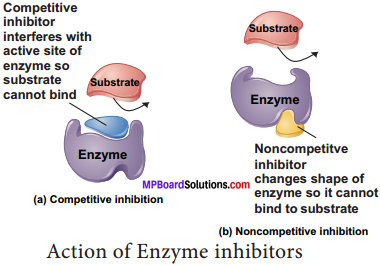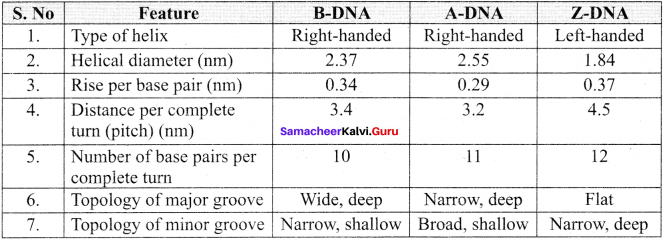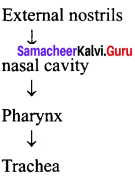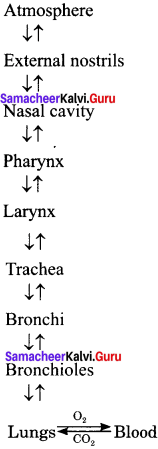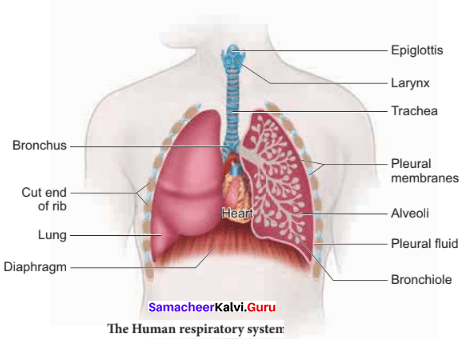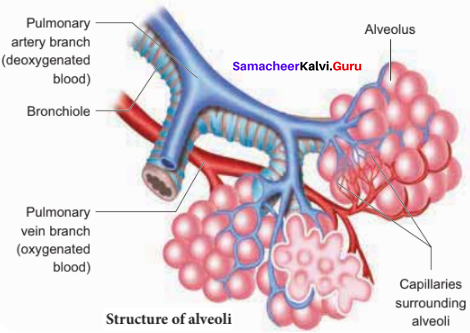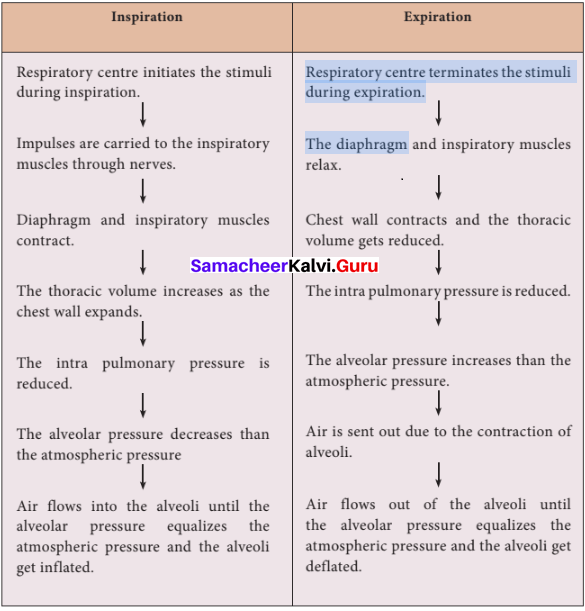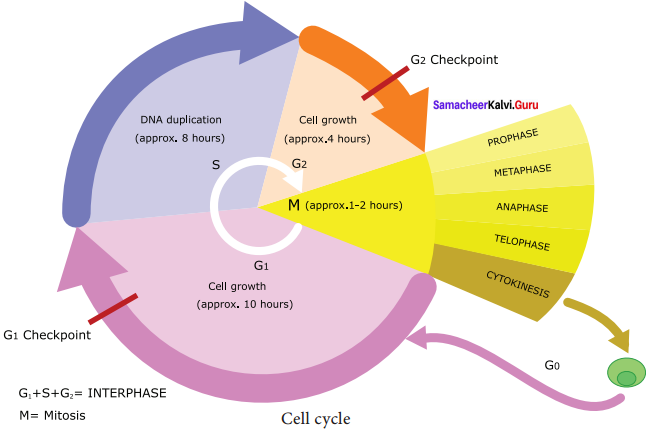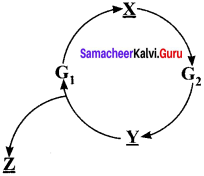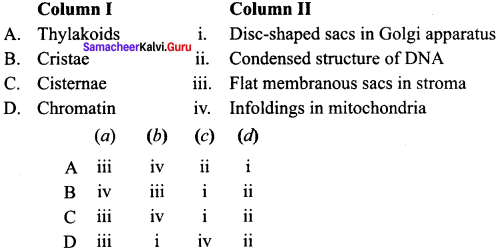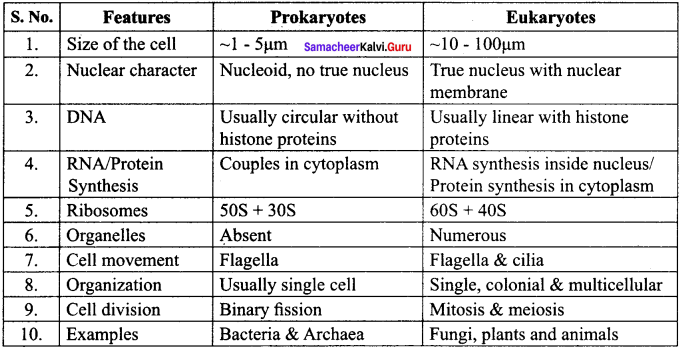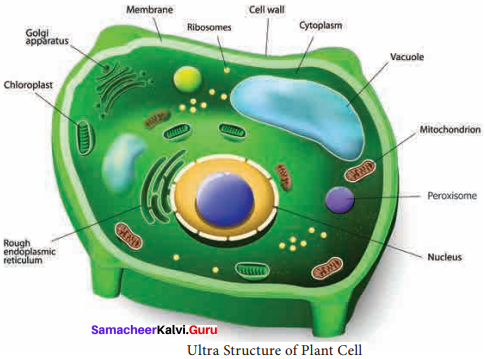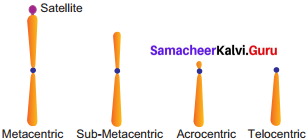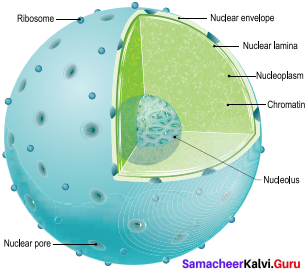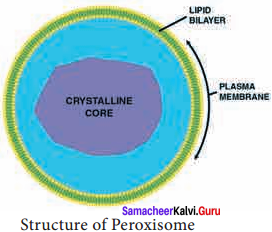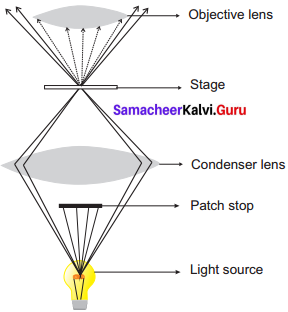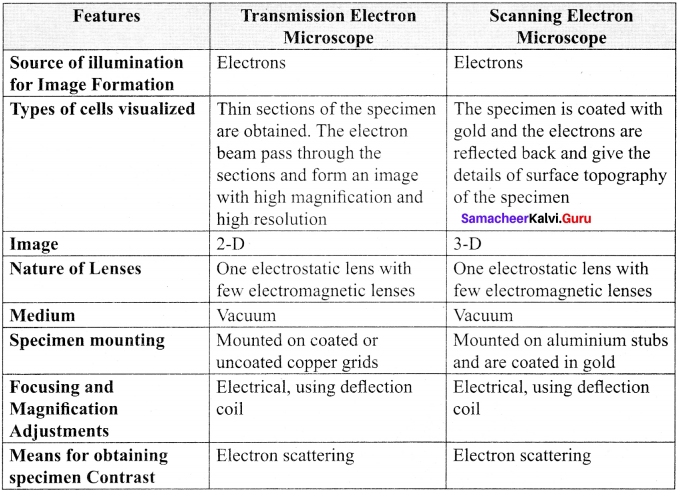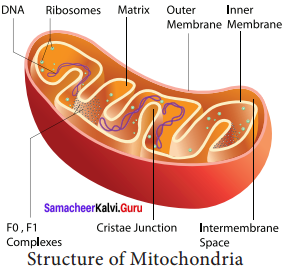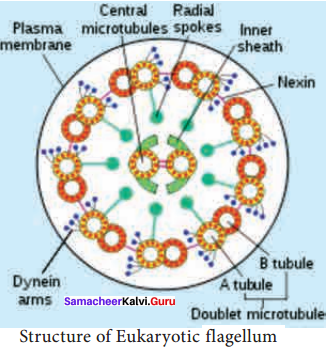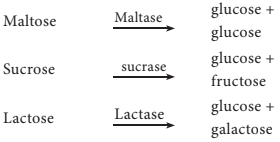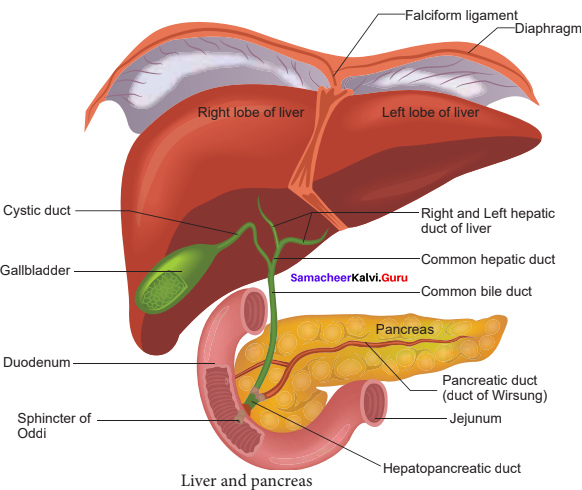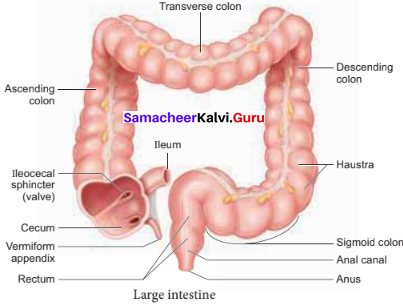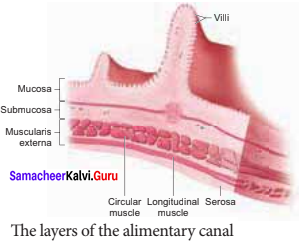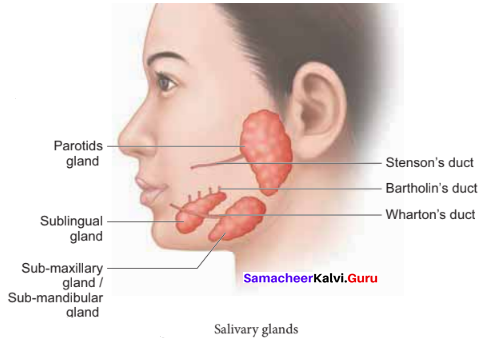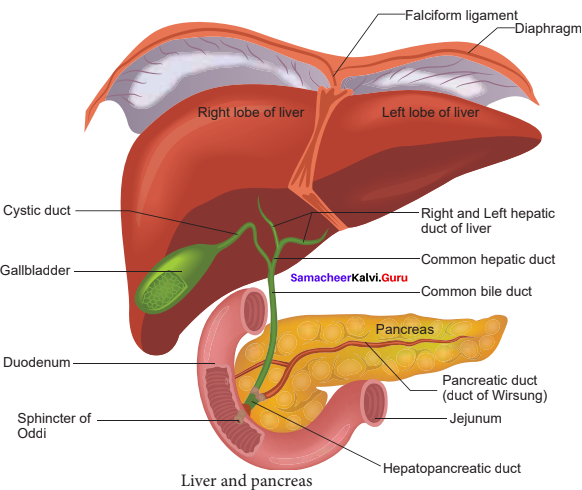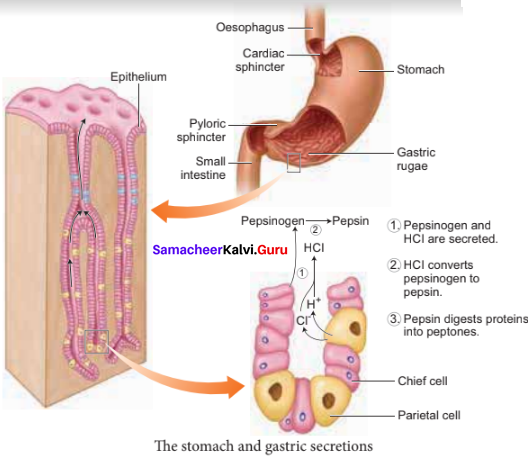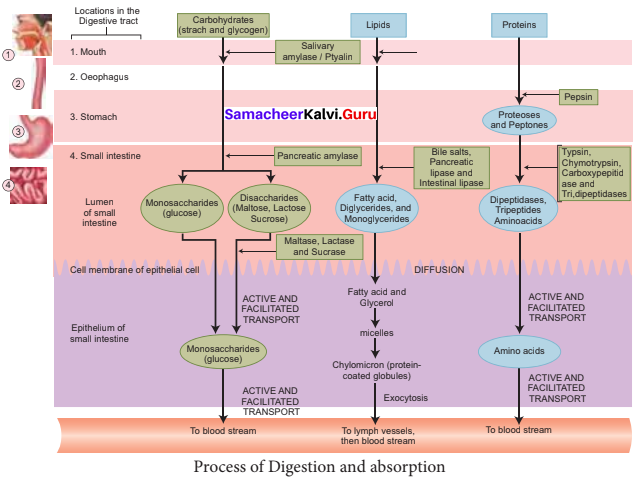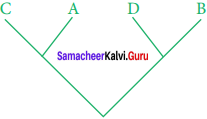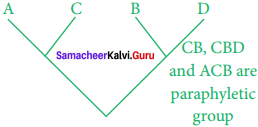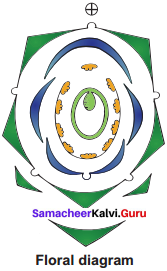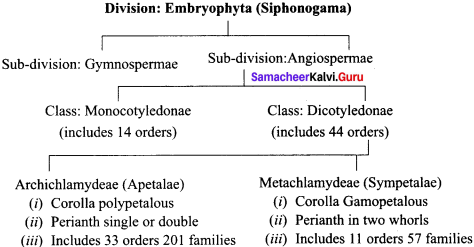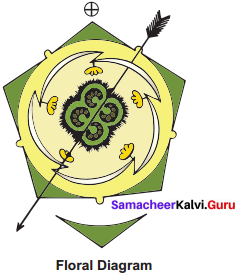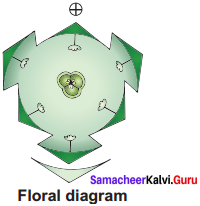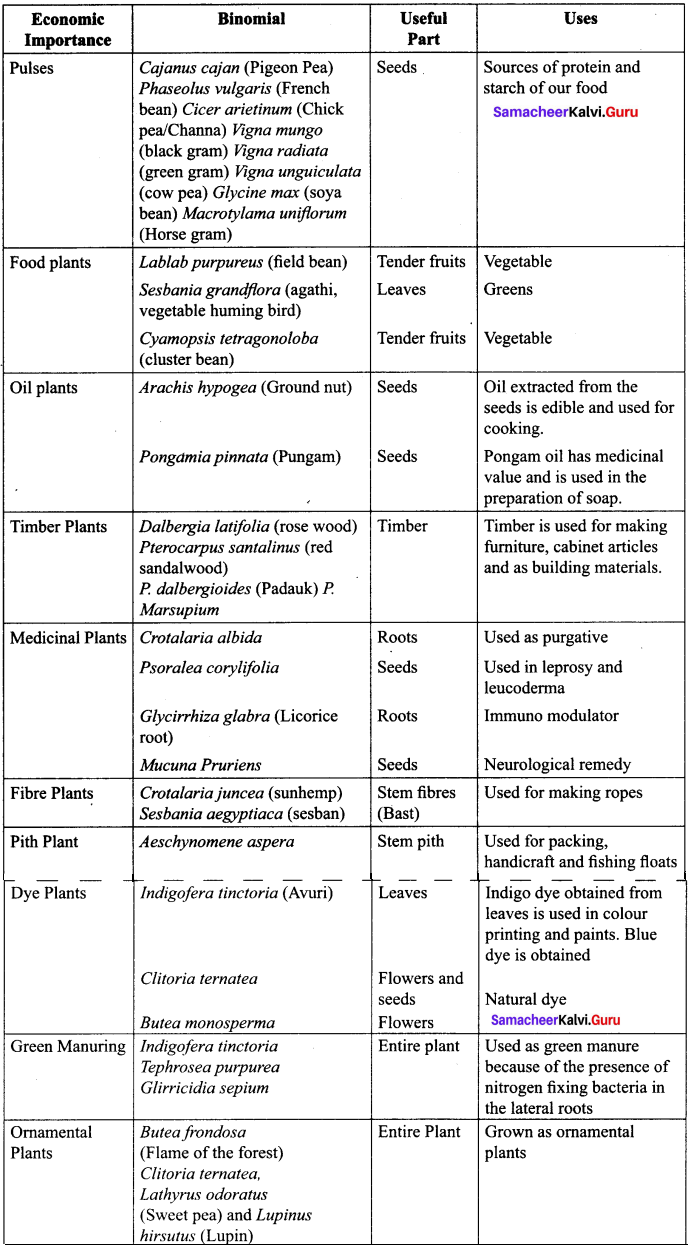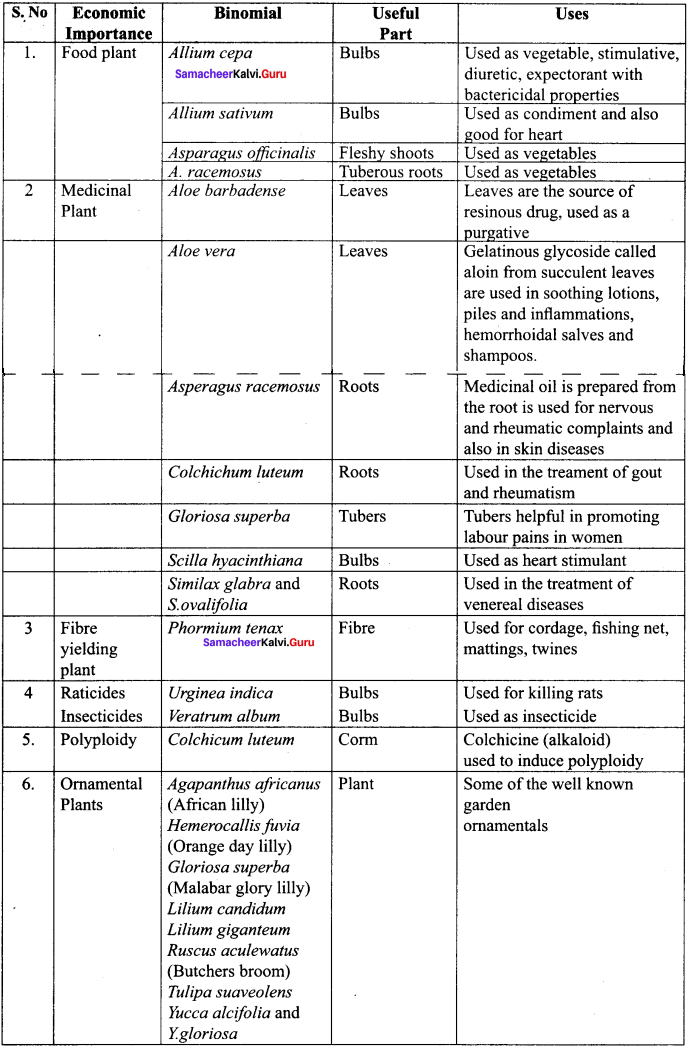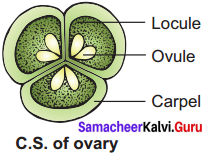Students who are in search of 11th Bio Botany exam can download this Tamilnadu State Board Solutions for 11th Bio Botany Chapter 11 Transport in Plants from here for free of cost. These cover all Chapter 11 Transport in Plants Questions and Answers, PDF, Notes, Summary. Download the Samacheer Kalvi 11th Biology Book Solutions Questions and Answers by accessing the links provided here and ace up your preparation.
Tamilnadu Samacheer Kalvi 11th Bio Botany Solutions Chapter 11 Transport in Plants
Kickstart your preparation by using this Tamilnadu State Board Solutions for 11th Bio Botany Chapter 11 Transport in Plants Questions and Answers get the max score in the exams. You can cover all the topics of Chapter 11 Transport in Plants Questions and Answers easily after studying the Tamilnadu State Board 11th Bio Botany Textbook solutions pdf.
Samacheer Kalvi 11th Bio Botany Transport in Plants Text Book Back Questions and Answers
I. Choose the correct answers.
Question 1.
In a fully turgid cell:
(a) DPD = 10 atm; OP = 5 atm; TP = 10 atm
(b) DPD = 0 atm; OP =10 atm; TP = 10 atm
(c) DPD = 0 atm; OP = 5 atm; TP = 10 atm
(d) DPD = 20 atm; OP = 20 atm; TP = 10 atm
Answer:
(b) DPD = 0 atm; OP =10 atm; TP = 10 atm
Question 2.
Which among the following is correct?
(i) Apoplast is fastest and operate in nonliving part
(ii) Trahsmembrane route includes vacuole
(iii) Symplast interconnect the nearby cell through plasmadesmata
(iv) Symplast and transmembrane route are in living part of the cell
(a) (i) and (ii) only
(b) (ii) and (iii) only
(c) (iii) and (iv) only
(d) All of these
Answer:
(c) (iii) and (iv) only
Question 3.
What type of transpiration is possible in the xerophyte Opuntia?
(a) Stomatal
(b) Lenticular
(c) Cuticular
(d) All the above
Answer:
(b) Lenticular
Question 4.
Stomata of a plant open due to:
(a) Influx of K+
(b) Efflux of K+
(c) Influx of Cl–
(d) Influx of OH–
Answer:
(a) Influx of K+
Question 5.
Munch hypothesis is based on:
(a) translocation of food due to TP gradient and imbibition force
(b) ranslocation of food due to TP
(c) translocation of food due to imbibition force
(d) None of the above
Answer:
(b) ranslocation of food due to TP
Question 6.
If the concentration of salt in the soil is too high and the plants may wilt even if the field is thoroughly irrigated. Explain.
Answer:
The salts present in the soil dissolve in the irrigated water and form hypertonic solution outside the root hairs of the plant and the root hairs cannot absorb water from hypertonic solution, since water molecules cannot move from hypertonic solution to hypotonic solution in the cells of root hair. Hence the plants become wilt even the field is irrigated.
Question 7.
How phosphorylase enzyme open the stomata in starch sugar interconversion theory?
Answer:
The discovery of enzyme phosphorylase in guard cells by Hanes (1940) greatly supports the starch – sugar interconversion theory. The enzyme phosphorylase hydrolyses starch into sugar and high pH followed by endosmosis and the opening of stomata during light. The vice versa takes place during the night.
Question 8.
List out the non photosynthetic parts of a plant that need a supply of sucrose?
Answer:
The non photosynthetic parts of a plant that need a supply of sucrose:
- Roots
- Tubers
- Developing fruits and
- Immature leaves.
Question 9.
What are the parameters which control water potential?
Answer:
Water potential (Ψ) can be controlled by,
- Solute concentration or Solute potential (Ψs)
- Pressure potential (Ψp).
By correlating two factors, water potential is written as, Ψw = Ψs + Ψp.
Water Potential = Solute potential + Pressure potential.
Question 10.
An artificial cell made of selectively permeable membrane immersed in a beaker (in the figure). Read the values ans answer the following questions?

Ψw = 0, Ψs = 2, Ψp = 0.
(a) Draw an arrow to indicate the direction of water movement.
(b) Is the solution outside the cell isotonic, hypotonic or hypertonic?
(c) Is the cell isotonic, hypotonic or hypertonic?
(d) Will the cell become more flaccid, more turgid or stay in original size?
(e) With reference to artificial cell state, the process is endosmosis or exosmosis? Give reasons.
Answer:
(a) An arrow to indicate the direction of water movement:
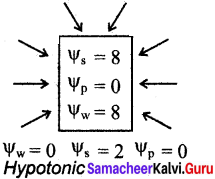
(b) Outside solution in hypotonic.
(c) The cell is hypertonic.
(d) The cell become more turgid.
(e) The process is endo – osmosis because the solvent (water) moves inside the cell.
Samacheer Kalvi 11th Bio Botany Transport in Plants Additional Questions & Answers
I. Choose the correct answer (1 Mark)
Question 1 .
In plants, cell to cell transport is aided by:
(a) diffusion alone
(b) osmosis alone
(c) imbibition alone
(d) all the three above
Answer:
(d) all the three above
Question 2.
In passive transport:
(a) no energy expenditure is required
(b) energy expenditure is required
(c) no involvement of physical forces like gravity
(d) no involvement of osmosis
Answer:
(a) no energy expenditure is required
Question 3.
Which of the following statements are correct?
(i) Cell membranes allow water and non polar molecules to permeate by simple diffusion.
(ii) Polar molecules like amino acids can also diffuse through membrane.
(iii) Smaller molecules diffuse faster than larger molecules.
(iv) Larger molecules diffuse faster than smaller molecules.
(a) (i) and (iv) only
(b) (i) and (iii) only
(c) (i) and (ii) only
(d) (ii) and (iv) only
Answer:
(b) (i) and (iii) only
Question 4.
In co – transport across membrane:
(a) two different molecules are transported in opposite direction.
(b) two types of molecules are transported the same direction.
(c) three types of molecules are transported in opposite direction.
(d) two types of molecules are transported in all directions.
Answer:
(b) two types of molecules are transported the same direction.
Question 5.
The swelling of dry seeds is due to phenomenon called:
(a) osmosis
(b) transpiration
(c) imbibition
(d) none of the above
Answer:
(c) imbibition
Question 6.
The concept of water potential was introduced by:
(a) Slatyer and Mosses
(b) Slatyer and Taylor
(c) Armusten and Taylor
(d) Mosses and Robert
Answer:
(b) Slatyer and Taylor
Question 7.
At standard temperature the water potential pure water is:
(a) 1.0
(b) -1.0
(c) 0.5
(d) zero
Answer:
(d) zero
Question 8.
Addition of solute to pure water:
(a) increases water potential
(b) does not change water potential
(c) decreases water potential
(d) does not change the gradient of water potential
Answer:
(b) does not change water potential
Question 9.
Osmotic pressure is increased with:
(a) decrease of dissolved solutes in the solution
(b) increase of dissolved solutes in the solution.
(c) increase of solvent in a solution
(d) isotonic condition of the solution
Answer:
(b) increase of dissolved solutes in the solution.
Question 10.
Diffusion Pressure Deficit (DPD) was termed by Meyer in:
(a) 1928
(b) 1828
(c) 1936
(d) 1938
Answer:
(d) 1938
Question 11.
The root hairs are:
(a) unicellular extensions of epidermal cells with cuticle
(b) Unicellular extensions of xylem parenchyma cells without cuticle
(c) Unicellular extensions of epidermal cells without cuticle
(d) None of the above
Answer:
(c) Unicellular extensions of epidermal cells without cuticle
Question 12.
Kramer (1949) recognised two distinct mechanisms, which independently operate in the absorption of water in plants are:
(a) osmosis and diffusion
(b) imbibition and diffusion
(c) diffusion and absorption
(d) active absorption and passive absorption
Answer:
(d) active absorption and passive absorption
Question 13.
Indicate the correct statements:
(i) the cell sap concentration in xylem is always high.
(ii) the cell sap concentration in xylem is not always high.
(iii) root pressure is not universal in all plants.
(iv) root pressure is universal in all plants.
(a) (i) and (iv) only
(b) (ii) and (iii) only
(c) (i) and (iii) only
(d) (ii) and (iv) only
Answer:
(b) (ii) and (iii) only
Question 14.
When respiratory inhibitors like KCN, chloroform are applied:
(a) there is a decrease in the rate of respiration and increase in the rate of absorption of water.
(b) there is an increase in the rate of respiration and decrease in the rate of absorption of water.
(c) there is a decrease in the rate of respiration and also decrease in the rate of absorption of water.
(d) there is an increase in the rate of respiration and also in the rate of absorption of water.
Answer:
(c) there is a decrease in the rate of respiration and also decrease in the rate of absorption of water.
Question 15.
Relay pump theory was proposed by:
(a) J.C. Bose
(b) Godlewski
(c) Stoking
(d) Strasburger
Answer:
(b) Godlewski
Question 16.
Pulsation theory was proposed by:
(a) Strasburger
(b) Godsey
(c) J.C. Bose
(d) C.V. Raman
Answer:
(c) J.C. Bose
Question 17.
The term ‘root pressure’ was coined by:
(a) Strasburger
(b) Stephen Hales
(c) Amstrong
(d) Overton
Answer:
(b) Stephen Hales
Question 18.
Indicate the correct statements:
(i) Root pressure is absent in gymnosperms.
(ii) Root pressure in totally absent in angiosperms.
(iii) There is a relationship between the ascent of sap and root pressure.
(iv) There is no relationship between the ascent of sap and root pressure.
(a) (i) and (ii)
(b) (ii) and (iii)
(c) (ii) and (iv)
(d) (i) and (iv)
Answer:
(d) (i) and (iv)
Question 19.
The capillary theory was suggested by:
(a) Unger
(b) J.C. Bose
(c) Boehm
(d) Sachs
Answer:
(c) Boehm
Question 20.
Cohesion and transpiration pull theory was originally proposed by:
(a) Unger and Sachs
(b) Xavier and Dixon
(c) Boehm and Jolly
(d) Dixon and Jolly
Answer:
(d) Dixon and Jolly
Question 21.
Loss of water from mesophyll cells causes:
(a) increase in water potential
(b) decrease in water potential
(c) does not change in water potential
(d) hone of the above events
Answer:
(b) decrease in water potential
Question 22.
The water may move through the xylem at the rate as fast as:
(a) 65 cm / min
(b) 85 cm / min
(c) 75 cm / min
(d) 45 cm / min
Answer:
(c) 75 cm / min
Question 23.
The length and breadth of stomata is:
(a) about 10 – 30μ and 2 – 10μ respectively
(b) about 10 – 14μ and 3 – 10μ respectively
(c) about 10 – 40μ and 3 – 10μ respectively
(d) about 5 – 30μ and 5 – 10μ respectively
Answer:
(c) about 10 – 40μ and 3 – 10μ respectively
Question 24.
The opening and closing of stomata depends upon the change in pH of guard cells. This is observed by:
(a) Loftfield
(b) Sayre
(c) Von Mohl
(d) Amstrong
Answer:
(b) Sayre
Question 25.
Who did observe that stomata open in light and close in the night:
(a) Unger
(b) Sachs
(c) Boehm
(d) Von Mohl
Answer:
(d) Von Mohl
Question 26.
The phosphorylase enzyme in guard cells supports the starch – sugar inter conversion theory. The above reaction is:
(a) oxidation reaction
(b) hydrolyses reaction
(c) reduction reaction
(d) none of the above
Answer:
(b) hydrolyses reaction
Question 27.
Low pH and a shortage of water in the guard cell activate the stress hormone namely:
(a) Ascorbic acid
(b) Malic acid
(c) Abscisic acid
(d) Salisilic acid
Answer:
(c) Abscisic acid
Question 28.
Accumulation of CO2 in plant cell during dark:
(a) increases the pH level
(b) decreases the pH level
(c) does not alter pH
(d) decreases in H+ ion concentration
Answer:
(b) decreases the pH level
Question 29.
Phenyl Mercuric Acetate (PMA), when applied as a foliar spray to plants:
(a) induces partial stomatal closure for two weeks.
(b) induces partial stomatal opening for two weeks.
(c) induces partial stomatal closure for four weeks.
(d) induces stomatal closure permanently
Answer:
(a) induces partial stomatal closure for two weeks.
Question 30.
The transpiration in plants is a “necessary evil” as stated by:
(a) Steward
(b) Sayre
(c) Curtis
(d) Meyer
Answer:
(c) Curtis
Question 31.
Sink in plants, which receives food from source is:
(a) tubers
(b) developing fruits
(c) roots
(d) all the three above
Answer:
(d) all the three above
Question 32.
Activated diffusion theory was first proposed by:
(a) Fenson and Spanner
(b) Mason and Masked
(c) Crafts and Munch
(d) Hanes and Robert
Answer:
(b) Mason and Masked
Question 33.
From sieve elements sucrose is translocated into sink organs such as root, tubers etc and this process is termed as:
(a) Xylem unloading
(b) Xylem uploading
(c) Phloem unloading
(d) Phloem uploading
Answer:
(c) Phloem unloading
Question 34.
In which plant, the petioles are flattened and widened, to become phyllode:
(a) Asparagus
(b) Acacia melanoxylon
(c) Vinca rosea
(d) Delonix regia
Answer:
(b) Acacia melanoxylon
Question 35.
Match the following:
| (i) Opuntia | (a) Cladode |
| (ii) Acacia | (b) Guttation |
| (iii) Asparagus | (c) Phyllode |
| (iv) Alocasia | (d) Phylloclade |
(a) i – b; ii – d; iii – a; iv – c
(b) i – b; ii – c; iii – d; iv – a
(c) i – d; ii – c; iii – a; iv – b
(d) i – c; ii – b; iii – d; iv – a
Answer:
(c) i – d; ii – c; iii – a; iv – b
Question 36.
Hydathodes are generally present in plants that grow in:
(a) dry places
(b) moist and shady places
(c) sunny places
(d) deserts
Answer:
(b) moist and shady places
Question 37.
Ganongs potometer is used to measure:
(a) the rate of photosynthesis
(b) the rate of gaseous exchange
(c) the rate of water transport
(d) the rate of transpiration
Answer:
(d) the rate of transpiration
Question 38.
Indicate the correct statement:
(a) Anti – transpirants increases the loss of water by transpiration.
(b) Anti – transpirants do not alter the rate of transpiration.
(c) Anti – transpirants do not decrease the loss water by transpiration in cross plants.
(d) Anti – transpirants reduce the enormous loss of wafer by transpiration in crop plants.
Answer:
(d) Anti – transpirants reduce the enormous loss of wafer by transpiration in crop plants.
Question 39.
The liquid coming out of hydathode of grasses is:
(a) pure water
(b) not pure water
(c) a solution containing a number of dissolved substances
(d) salt water
Answer:
(c) a solution containing a number of dissolved substances
Question 40.
A dry cobalt chloride strip, when hydrated, turns:
(a) white
(b) red
(c) green
(d) pink
Answer:
(d) pink
II. Answer the following (2 Marks)
Question 1.
What is the need for transport of materials in plants?
Answer:
Water absorbed from roots must travel up to leaves by xylem for food preparation by photosynthesis. Likewise, food prepared from leaves has to travel to all parts of the plant including roots.
Question 2.
What are the types of transport based on the distance travelled by the materials?
Answer:
Based on the distance travelled by water (sap) or food (solute) they are classified as
- Short distance (cell to cell transport)
- Long distance transport.
Question 3.
Define the term diffusion.
Answer:
The net movement of molecules from a region of their higher concentration to a region of their lower concentration along a concentration gradient until an equilibrium is attained.
Question 4.
Define the term semipermeable.
Answer:
Semipermeable allow diffusion of solvent molecules but do not allow the passage of solute molecule. eg: Parchment paper.
Question 5.
What is meant by Porin?
Answer:
Porin is a large transporter protein found in the outermembrane of plastids, mitochondria and bacteria which facilitates smaller molecules to pass through the membrane.
Question 6.
Define symport or co – transport?
Answer:
The term symport is used to denote an integral membrane protein that simultaneously transports two types of molecules across the membrane in the same direction.
Question 7.
Explain the term counter transport.
Answer:
An antiport is an integral membrane transport protein that simultaneously transports two different molecules, in opposite directions, across the membrane.
Question 8.
What is the difference between co – transport and counter transport?
Answer:
In co – transport, two molecules are transported together whereas, in counter transport two molecules are transported in opposite direction to each other.
Question 9.
Define the term Imbibition.
Answer:
Colloidal systems such as gum, starch, proteins, cellulose, agar, gelatin when placed in water, will absorb a large volume of water and swell up. These substances are called imbibants and the phenomenon is imbibition.
Question 10.
Give two examples for the phenomenon of Imbibition.
Answer:
two examples for the phenomenon of Imbibition:
- The swelling of dry seeds.
- The swelling of wooden windows, tables, doors due to high humidity during the rainy season.
Question 11.
Define the term osmotic potential.
Answer:
Osmotic potential is defined as the ratio between the number of solute particles and the number of solvent particles in a solution.
Question 12.
What is transpiration?
Answer:
The loss of excess of water in the form of vapour from various aerial parts of the plant is called transpiration.
Question 13.
What is meant by osmotic pressure?
Answer:
When a solution and its solvent (pure water) are separated by a semipermeable membrane, a pressure is developed in the solution, due to the presence of dissolved solutes. This is called osmotic pressure (OP).
Question 14.
Explain the term wall pressure exerted by the cell wall.
Answer:
The cell wall reacts to this turgor pressure with equal and opposite force, and the counter – pressure exerted by the cell wall towards cell membrane is wall pressure (WP).
Question 15.
Define the term osmosis.
Answer:
Osmosis (Latin: Osmos – impulse, urge) is a special type of diffusion. It represents the movement of water or solvent molecules through a selectively permeable membrane from the place of its higher concentration (high water potential) to the place of its lower concentration (low water potential).
Question 16.
What is meant by isotonic solution?
Answer:
Isotonic (Iso = identical; tonic = soute): It refers to two solutions having same concentration. In this condition the net movement of water molecule will be zero.
Question 17.
What are the three types of plasmolysis?
Answer:
Three types of plasmolysis occur in plants:
- Incipient plasmolysis
- Evident plasmolysis
- Final plasmolysis.
Question 18.
Explain briefly about root hairs.
Answer:
Root hairs are unicellular extensions of epidermal cells without cuticle. Root hairs are extremely thin and numerous and they provide a large surface area for absorption.
Question 19.
Define active absorption of water.
Answer:
The mechanism of water absorption due to forces generated in the root itself is called active absorption. Active absorption may be osmotic or non – osmotic.
Question 20.
Explain briefly the term stomatal transpiration.
Answer:
Stomata are microscopic structures present in high number on the lower epidermis of leaves. This is the most dominant form of transpiration and being responsible for most of the water loss (90 – 95%) in plants.
Question 21.
Give any two objections to starch – sugar inter conversion theory.
Answer:
Two objections to starch – sugar inter conversion theory:
- In monocots, guard cell does not have starch.
- There is no evidence to show the presence of sugar at a time when starch disappears and stomata open.
Question 22.
Briefly explain plant anti – transpirants.
Answer:
The term anti – transpirant is used to designate any Material applied to plants for the purpose of retarding transpiration. An ideal anti – transpirant checks the transpiration process without disturbing the process of gaseous exchange.
Question 23.
Mention any two uses of anti – transpirants.
Answer:
Two uses of anti – transpirants:
- Anti – transpirants reduce the enormous loss of water by transpiration in crop plants.
- Useful for seedling transplantations in nurseries.
Question 24.
What is meant by translocation of organic solutes.
Answer:
The phenomenon of food transportation from the site of synthesis to the site of utilization is known as translocation of organic solutes. The term solute denotes food material that moves in a solution.
Question 25.
Define the term Ion – Exchange.
Answer:
Ions of external soil solution are exchanged with same charged (anion for anion or cation for cation) ions of the root cells.
III. Answer the following (3 Marks)
Question 1.
Briefly explain the term aquaporin.
Answer:
Aquaporin Is a water channel protein embedded in the plasma membrane. It regulates the massive amount of water transport across the membrane. Plants contain a variety of aquaporins. Over 30 types of aquaporins are known from maize.
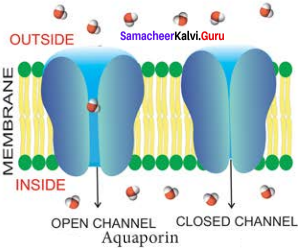
Currently, they are also recognised to transport substrates like glycerol, urea, CO2, NH3, rhetalloids, and reactive oxygen species (ROS) in addition to water. They increase the permeabi lity of the membrane to water. They confer drought and salt stress tolerance.
Question 2.
What is carrier protein? Mention the. three types of carrier proteins?
Answer:
Carrier protein acts as a vehicle to carry molecules from outside of the membrane to inside the cell and vice versa. Due to association with molecules to be transported, the structure of carrier protein gets modified until the dissociation of the molecules.
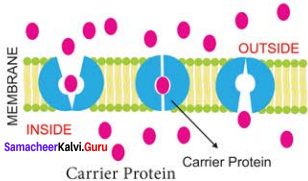
There are three types of carrier proteins classified on the basis of handling of molecules and direction of transport. They are:
- Uniport
- Symport
- Antiport.
Question 3.
Explain osmotic potential.
Answer:
Solute potential, otherwise known as osmotic potential denotes the effect of dissolved solute on water potential. In pure water, the addition of solute reduces its free energy and lowers the water potential value from zero to negative. Thus the value of solute potential is always negative. In a solution at standard atmospheric pressure, water potential is always equal to solute potential (Ψw = Ψs).
Question 4.
What are the types of osmosis based on the direction of the movement of water? Explain briefly.
Answer:
Based on the direction of movement of water or solvent in an osmotic system, two types of osmosis can occur, they are Endosmosis and Exosmosis:
- Endosmosis: Endosmosis is defined as the osmotic entry of solvent into a cell or a system when it is placed in a pure water or hypotonic solution. eg: dry raisins (high solute and low solvent) placed in the water, it swells up due to turgidity.
- Exosmosis: Exosmosis is defined as the osmotic withdrawal of water from a cell or system when it is placed in a hypertonic solution. Exosmosis in a plant cell leads to plasmolysis.
Question 5.
Describe the method of demonstration of endo – osmosis by potato Osmoseope.
Answer:
The method of demonstration of endo – osmosis by potato Osmoscope:
- Take a peeled potato tuber and make a cavity inside with the help of a knife.
- Fill the cavity with concentrated sugar solution and mark the initial level.
- Place this setup in a beaker of pure water.
- After 10 minutes observe the sugar solution level and record your findings.
- With the help of your teacher discuss the results.
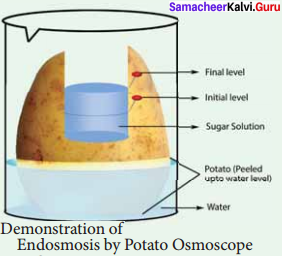
Instead of potato use beetroot or bottleguard and repeat the above experiment. Compare and discuss the results.
Question 6.
Explain the term reverse osmosis.
Answer:
Reverse Osmosis follows the same principles of osmosis, but in the reverse direction. In this process movement of water is reversed by applying pressure to force the water against a concentration gradient of the solution.
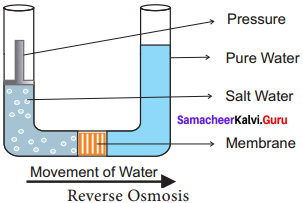
In regular osmosis, the water molecules move from the higher concentration (pure water = hypotonic) to lower concentration (salt water = hypertonic). But in reverse osmosis, the water molecules move from the lower concentration (salt water = hypertonic) to higher concentration (pure water = hypotonic) through a selectively permeable membrane.
Uses: Reverse osmosis is used for purification of drinking water and desalination of seawater.
Question 7.
Give details of symplast route of water movement.
Answer:
The symplast (Greek: sym = within; plast = cell) consists of the entire mass of cytosol of all the living cells in a plant, as well as the plasmodesmata, the cytoplasmic channel that interconnects them. In the symplastic route, water has to cross plasma membrane to enter the cytoplasm of outer root cell; then it will move within adjoining cytoplasm through plasmodesmata around the vacuoles without the necessity to cross more membrane, till it reaches xylem.
Question 8.
Describe the non – osmotic active absorption theory proposed by Bennet – Clark in 1936.
Answer:
Bennet – Clark (1936), Thimann (1951) and Kramer (1959) observed absorption of water even if the concentration of cell sap in the root hair is lower than that of the soil water. Such a movement requires an expenditure of energy released by respiration (ATP). Thus, there is a link between water absorption and respiration. It is evident from the fact that when respiratory inhibitors like KCN, Chloroform are applied there is a decrease in the rate of respiration and also the rate of absorption of water.
Question 9.
Mention the objections to vital force theory of Ascent of sap.
Answer:
The objections to vital force theory of Ascent of sap:
- Strasburger (1889) and Overton (1911) experimentally proved that living cells are not mandatory for the ascent of sap. For this, he selected an old oak tree trunk which when immersed in picric acid and subjected to excessive heat killed all the living cells of the trunk. The trunk when dipped in water, the ascent of sap took place.
- Pumping action of living cells should be in between two xylem elements (vertically) and not on lateral sides.
Question 10.
Explain the capillary theory of Boehm (1809).
Answer:
Capillary theory: Boehm (1809) suggested that the xylem vessels work like a capillary tube. This capillarity of the vessels under normal atmospheric pressure is responsible for the ascent of sap. This theory was rejected because the magnitude of capillary force can raise water level only up to a certain height. Further, the xylem vessels are broader than the tracheid which actually conducts more water and against the capillary theory.
Question 11.
Give a brief account of Lenticular transpiration.
Answer:
In stems of woody plants and trees, the epidermis is replaced by periderm because of secondary growth. In order to provide gaseous exchange between the living cells and outer atmosphere, some pores which looks like lens – shaped raised spots are present on the surface of the stem called Lenticels. The loss of water from lenticels is very insignificant as it amounts to only 0.1% of the total.
Question 12.
Explain the theory of photosynthesis in guard cells observed by Von Mohl with its demerits.
Answer:
Von Mohl (1856) observed that stomata open in light and close in the night. According to him, chloroplasts present in the guard cells photosynthesize in the presence of light resulting in the production of carbohydrate (Sugar) which increases osmotic pressure in guard cells. It leads to the entry of water from other cell and stomatal aperture opens. The above process vice versa in night leads to closure of stomata.
Demerits:
- Chloroplast of guard cells is poorly developed and incapable of performing photosynthesis.
- The guard cells already possess much amount of stored sugars.
Question 13.
What are the three types of wilting in plants? Explain them briefly.
Answer:
In general, there are three types of wilting as follows:
- Incipient wilting: Water content of plant cell decreases but the symptoms are not visible.
- Temporary wilting: On hot summer days, the freshness of herbaceous plants reduces turgor pressure at the day time and regains it at night.
- Permanent wilting: The absorption of water virtually ceases because the plant cell does not get water from any source and the plant cell passes into a state of permanent wilting.
Question 14.
Define guttation. Explain it with examples.
Answer:
During high humidity in the atmosphere, the rate of transpiration is much reduced. When plants absorb water in such a condition root pressure is developed due to excess water within the plant. Thus excess water exudates as liquid from the edges of the leaves and is called guttation. eg: Grasses, tomato, potato, brinjal and Alocasia.
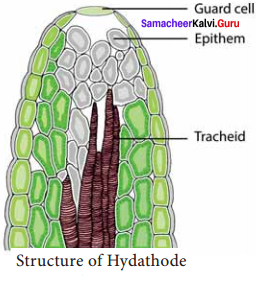
Guttation occurs through stomata like pores called hydathodes generally present in plants that grow in moist and shady places. Pores are present over a mass of loosely arranged cells with large intercellular spaces called epithem. This mass of tissue lies near vein endings (xylem and Phloem). The liquid coming out of hydathode is not pure water but a solution containing a number of dissolved substances.
Question 15.
What is the significance of transpiration in plants?
Answer:
Transpiration leads to loss of water, as 95% of absorbed water is lost in transpiration. It seems to be an evil process to plants. However, number of process like absorption of water, ascent of sap and mineral absorption – directly relay on the transpiration. Moreover plants withstand against scorching sunlight due to transpiration. Hence the transpiration is a “necessary evil” as stated by Curtis.
Question 16.
What do you understand by the source and sink organ of plant?
Answer:
The source organ: Source is defined as any organ in plants which are capable of exporting food materials to the areas of metabolism or to the areas of storage. eg: Mature leaves, germinating seeds.
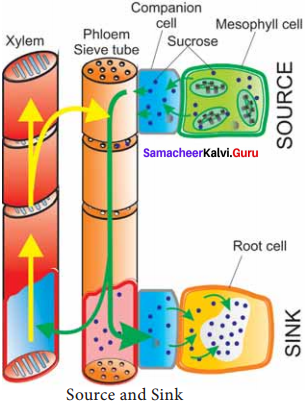
Sink organ: Sink is defined as any organ in plants which receives food from source. eg: Roots, tubers, developing fruits and immature leaves.
Question 17.
Why plants transport sugars as sucrose and not as starch or glucose or fructose?
Answer:
Glucose and Fructose are simple monosaccharides, whereas, Sucrose is a disaccharide composed of glucose and fructose. Starch is a polysaccharide of glucose. Sucrose and starch are more efficient in energy storage when compared to glucose and fructose, but starch is insoluble in water. So it cannot be transported via phloem and the next choice is sucrose, being water soluble and energy efficient, sucrose is chosen as the carrier of energy from leaves to different parts of the plant.
Sucrose has low viscosity even at high concentrations and has no reducing ends which makes it inert than glucose or fructose. During photosynthesis, starch is synthesized and stored in the chloroplast stroma and sucrose is synthesized in the leaf cytosol from which it diffuses to the rest of the plant.
Question 18.
What is meant by phloem unloading?
Answer:
From sieve elements sucrose is translocated into sink organs such as roots, tubers, flowers and fruits and this process is termed as phloem unloading. It consists of three steps:
- Sieve element unloading: Sucrose leave from sieve elements.
- Short distance transport: Movement of sucrose to sink cells.
- Storage and metabolism: The final step when sugars are stored or metabolized in sink cells.
Question 19.
Explain the term Donnam equilibrium.
Answer:
Within the cell, some of the ions never diffuse out through the membrane. They are trapped within the cell and are called fixed ions. But they must be balanced by the ions of opposite charge. Assuming that a concentration of fixed anions is present inside the membrane, more cations would be absorbed in addition to the normal exchange to maintain the equilibrium. Therefore, the cation concentration would be greater in the internal than in the external solution. This electrical balance or equilibrium controlled by electrical as well as diffusion phenomenon is known as the Donnan equilibrium.
IV. Answer the following (5 Marks)
Question 1.
Define the term osmosis. Give details of the types of osmosis in plants.
Answer:
1. Osmosis (Latin: Osmos – impulse, urge) is a special type of diffusion. It represents the movement of water or solvent molecules through a selectively permeable membrane from the place of its higher concentration (high water potential) to the place of its lower concentration (low water potential). Types of Solutions based on concentration:
- Hypertonic (Hyper = High; tonic = solute): This is a strong solution (low solvent / high solute / low Ψ) which attracts solvent from other solutions.
- Hypotonic (Hypo – low; tonic = solute): This is a weak solution (high sol vent / low or zero solute/ high Ψ) and it diffuses water out to other solutions.
- Isotonic (Iso = identical; tonic = soute): It refers to two solutions having same concentration. In this condition the net movement of water molecule will be zero.
The term hyper, hypo and isotonic are relative terms which can be used only in comparison with another solution.
2. Types of osmosis: Based on the direction of movement of water or solvent in an osmotic system, two types of osmosis can occur, they are Endosmosis and Exosmosis.
- Endosmosis: Endosmosis is defined as the osmotic entry of solvent into a cell or a system when it is placed in a pure water or hypotonic solution. eg: dry raisins . (high solute and low solvent) placed in the water, it swells up due to turgidity.
- Exosmosis: Exosmosis is defined as the osmotic withdrawal of water from a cell or system when it is placed in a hypertonic solution. Exosmosis in a plant cell leads to plasmolysis.
Question 2.
Give an account of active absorption theories with their demerits.
Answer:
The mechanism of water absorption due to forces generated in the root itself is called active absorption. Active absorption may be osmotic or non – osmotic.
1. Osmotic active absorption: The theory of osmotic active absorption was postulated by Atkins (1916) and Preistley (1923). According to this theory, the first step in the absorption is soil water imbibed by cell wall of the root hair followed by osmosis. The soil water is hypotonic and cell sap is hypertonic. Therefore, soil water diffuses into root hair along the concentration gradient (endosmosis).
When the root hair becomes fully turgid, it becomes hypotonic and water moves osmotically to the outer most cortical cell. In the same way, water enters into inner cortex, endodermis, pericycle and finally reaches protoxylem. As the sap reaches the protoxylem a pressure is developed known as root pressure. This theory involves the symplastic movement of water.
2. Objections to osmotic theory:
- The cell sap concentration in xylem is not always high
- Root pressure is not universal in all plants especially in trees.
3. Non – Osmotic active absorption: Bennet – Clark (1936), Thimann (1951) and Kramer (1959) observed absorption of water even if the concentration of cell sap in the root hair is lower than that of the soil water. Such a movement requires an expehditure of energy released by respiration (ATP). Thus, there is a link between water absorption and respiration. It is evident from the fact that when respiratory inhibitors like KCN, Chloroform are applied there is a decrease in the rate of respiration and also the rate of absorption of water.
Question 3.
Explain in detail about the cohesion tension theory proposed by Dixon and Jolly (1894).
Answer:
(i) Strong cohesive force or tensile strength of water: Water molecules have the strong mutual force of attraction called cohesive mutual force of attraction called cohesive force due to which they cannot be easily separated from one another. Further, the attraction between a water molecule and the wall of the xylem element is called adhesion. These cohesive and adhesive force works together to form an unbroken continuous water column in the xylem. The magnitude of the cohesive force is much high (350 atm) and is more than enough to ascent sap in the tallest trees.
(ii) Continuity of the water column in the plant: An important factor which can break the water column is the introduction of air bubbles in the xylem. Gas bubbles expanding and displacing water within the xylem element is called cavitation or embolism. However, the overall continuity of the water column remains undisturbed since water diffuses into the adjacent xylem elements for continuing ascent of sap.
(iii) Transpiration pull or Tension in the unbroken water column: The unbroken water column from leaf to root is just like a rope. If the rope is pulled from the top, the entire rope will move upward. In plants, such a pull is generated by the process of transpiration which is known as transpiration pull. Water vapour evaporates from mesophyll cells to the intercellular spaces near stomata as a result of active transpiration.
The water vapours are then transpired through the stomatal pores. Loss of water from mesophyll cells causes a decrease in water potential. So, water moves as a pull from cell to cell along the water potential gradient. This tension, generated at the top (leaf) of the unbroken water column, is transmitted downwards from petiole, stem and finally reaches the roots. The cohesion theory is the most accepted among the plant physiologists today.
Question 4.
Describe the theory of K+ transport theory of stomatal opening.
Answer:
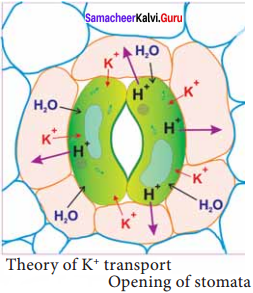
This theory was proposed by Levit (1974) and elaborated by Raschke (1975). According to this theory, the following steps are involved in the stomatal opening:
In light:
- In guard cell, starch is converted into organic acid (malic acid).
- Malic acid in guard cell dissociates to malate anion and proton (H+).
- Protons are transported through the membrane into nearby subsidiary cells with the exchange of K+ (Potassium ions) from subsidiary cells to guard cells. This process involves an electrical gradient and is called ion exchange.
- This ion exchange is an active process and consumes ATP for energy.
- Increased K+ ions in the guard cell are balanced by Cl– ions. Increase in solute concentration decreases the water potential in the guard cell.
- Guard cell becomes hypertonic and favours the entry of water from surrounding cells.
- Increased turgor pressure due to the entry of water opens the stomatal pore.
In Dark:
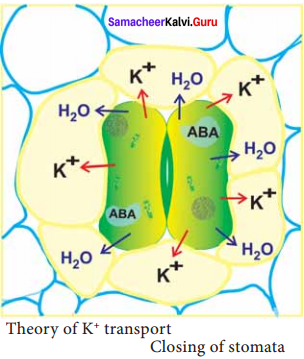
- In dark photosynthesis stops and respiration continues with accumulation of CO2 in the sub-stomatal cavity.
- Accumulation of CO2 in cell lowers the pH level.
- Low pH and a shortage of water in the guard cell activate the stress hormone Abscisic acid (ABA).
- ABA stops further entry of K+ ions and also induce K+ ions to leak out to subsidiary cells from guard cell.
- Loss of water from guard cell reduces turgor pressure and causes closure of stomata.
Question 5.
Give an account of external factors, which affect the rate of transpiration.
Answer:
External or Environmental factors:
1. Atmospheric humidity: The rate of transpiration is greatly reduced when the atmosphere is very humid. As the air becomes dry, the rate of transpiration is also increased proportionately.
2. Temperature: With the increase in atmospheric temperature, the rate of transpiration also increases. However, at very high – temperatures stomata closes because of flaccidity and transpiration stop.
3. Light: Light intensity increases the temperature. As in temperature, transpiration is increased in high light intensity and is decreased in low light intensity. Light also increases the permeability of the cell membrane, making it easy for water molecules to move out of the cell.
4. Wind velocity: In still air, the surface above the stomata get saturated with water vapours and there is no need for more water vapour to come out. If the wind is breezy, water vapour gets carried away near leaf surface and DPD is created to draw more vapour from the leaf cells enhancing transpiration. However, high wind velocity creates an extreme increase in water loss and leads to a reduced rate of transpiration and stomata remain closed.
5. Atmospheric pressure: In low atmospheric pressure, the rate of transpiration increases. Hills favour high transpiration rate due to low atmospheric pressure. However, it is neutralized by low temperature prevailing in the hills.
6. Water: Adequate amount of water in the soil is a pre – requisite for optimum plant growth. Excessive loss of water through transpiration leads to wilting.
Question 6.
Describe the method of Ganongs potometer to measure the rate of transpiration.
Answer:
Ganongs potometer is used to measure the rate of transpiration indirectly. In this, the amount of water absorbed is measured and assumed that this amount is equal to the amount of water transpired. Apparatus consists of a horizontal graduated tube which is bent in opposite directions at the ends. One bent end is wide and the other is narrow. A reservoir is fixed to the horizontal tube near the wider end. The reservoir has a stopcock to regulate water flow. The apparatus is filled with water from reservoir.
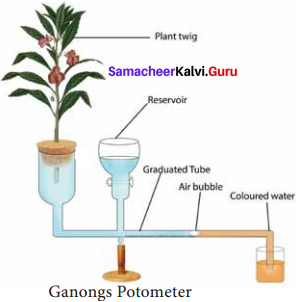
A twig or a small plant is fixed to the wider arm through a split cock. The other bent end of the horizontal tube is dipped into a beaker containing coloured water. An air bubble is introduced into the graduated tube at the narrow end. Keep this apparatus in bright sunlight and observe. As transpiration takes place, the air bubble will move towards the twig. The loss is compensated by water absorption through the xylem portion of the twig. Thus, the rate of water absorption is equal to the rate of transpiration.
Question 7.
Explain Munch Mass Flow Hypothesis with its merits and objections.
Answer:
Mass flow theory was first proposed by Munch (1930) and elaborated by Crafts (1938). According to this hypothesis, organic substances or solutes move from the region of high osmotic pressure (from mesophyll) to the region of low osmotic pressure along the turgor pressure gradient. The principle involved in this hypothesis can be explained by a simple physical system as shown in figure.
Two chambers “A” and “B” made up of semipermeable membranes are connected by tube “T” immersed in a reservoir of water. Chamber “A” contains highly concentrated sugar solution while chamber “B” contains dilute sugar solution. The following changes were observed in the system.
- The high concentration sugar solution of chamber “A” is in a hypertonic state which draws water from the reservoir by endosmosis.
- Due to the continuous entry of water into chamber “A”, turgor pressure is increased.
- Increase in turgor pressure in chamber “A” force, the mass flow of sugar solution to chamber “B” through the tube “T” along turgor pressure gradient.
- The movement of solute will continue till the solution in both the chambers attains the state of isotonic condition and the system becomes inactive.
- However, if new sugar solution is added in chamber “A”, the system will start to run again.
A similar analogous system as given in the experiment exists in plants:
Chamber “A” is analogous to mesophyll cells of the leaves which contain a higher concentration of food material in soluble form. In short “A” is the production point called “source”. Chamber “B” is analogous to cells of stem and roots where the food material is utilized. In short “B” is consumption end called “sink”. Tube “T” is analogous to the sieve tube of phloem.
Mesophyll cells draw water from the xylem (reservoir of the experiment) of the leaf by endosmosis leading to increase in the turgor pressure of mesophyll cell. The turgor pressure in the cells of stem and the roots are comparatively low and hence, the soluble organic solutes begin to flow en masse from mesophyll through the phloem to the cells of stem and roots along the gradient turgor pressure.
In the cells of stem and roots, the organic solutes are either consumed or converted into insoluble form and the excess water is released into xylem (by turgor pressure gradient) through cambium.
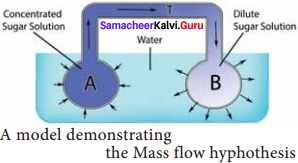
Merits:
- When a woody or herbaceous plant is girdled, the sap contains high sugar containing exudates from cut end.
- Positive concentration gradient disappears when plants are defoliated.
Objections:
- This hypothesis explains the unidirectional movement of solute only. However, bidirectional movement of solute is commonly observed in plants.
- Osmotic pressure of mesophyll cells and that of root hair do not confirm the requirements.
- This theory gives passive role to sieve tube and protoplasm, while some workers demonstrated the involvement of ATP.
Question 8.
Write an essay on Lunde – gardh’s cytochrome pump theory of mineral transport.
Answer:
Lundegardh and Burstrom (1933) observed a correlation between respiration and anion absorption. When a plant is transferred from water to a salt solution the rate of respiration increases which is called,as anion respiration or salt respiration. Based on this observation Lundegardh (1950 and 1954) proposed cytochrome pump theory which is based on the following assumptions:
- The mechanism of anion and cation absorption are different.
- Anions are absorbed through cytochrome chain by an active process, cations are absorbed passively.
- An oxygen gradient responsible for oxidation at the outer surface of the membrane and reduction at the inner surface.
According to this theory, the enzyme dehydrogenase on inner surface is responsible for the formation of protons (H+) and electrons (e–). As electrons pass outward through electron transport chain there is a corresponding inward passage of anions.
Anions are picked up by oxidized cytochrome oxidase and are transferred to other members of chain as they transfer the electron to the next component. The theory assumes that cations (C+) move passively along the electrical gradient created by the accumulation of anions (A–) at the inner surface of the membrane.
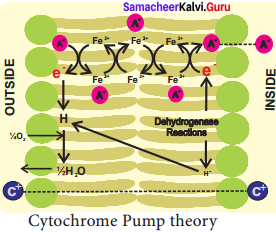
Main defects of the above theory are:
- Cations also induce respiration.
- Fails to explain the selective uptake of ions.
- It explains absorption of anions only.
Solution To Activity
Textbook Page No: 63
Question 1.
Imbibition experiment: Collect 5 gm of gum from Drumstick tree or Babool tree or Almond tree. Immerse in 100 ml of water. After 24 hours observe the changes and discuss the results with your teacher.
Answer:
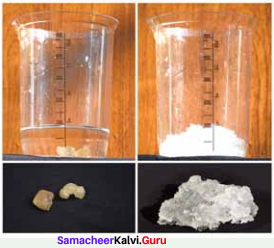
The gum will absorb large amount of water and swells. The phenomenon is called imbibition.
Textbook Page No: 65
Question 1.
Find the role of turgor pressure in sudden closing of leaves when we touch the ‘touch me not’ plant.
Answer:
When touched, this sensitive leaf reacts to stimulus as there is a higher pressure at that point and water in the vacuoles of the cells of the leaf lose water to the adjacent cell. This causes the leaves to close. If the leaves are left undisturbed for a few seconds, they slowly open up again and regain turgidity.
Textbook Page No: 75
Question 1.
Select a leafy twig of fully grown plant in your school campus. Cover the twig with a transparent polythene bag and tie the mouth of the bag at the base of the twig. Observe the changes after two hours and discuss with your teacher.
Answer:
Two hours and discuss with your teacher:
- Select a leafy twig of a fully grown plant.
- Cover the twig in a transparent polythene bag.
- Tie the mouth of the bag.
- Observe the bag after two hours.
- Observation: Moisture will be observed inside the plastic bag because of transpiration of water from the plant twig.
Textbook Page No: 79
Question 1.
What will happen if an indoor plant is placed under fan and AC?
Answer:
When an indoor plant is placed under fan and AC, the transpiration of water from the plant may increase, because the wind from fan and the humidity from AC will increase transpiration of water from the plant.
Believing that the Samacheer Kalvi 11th Biology Book Solutions Questions and Answers learning resource will definitely guide you at the time of preparation. For more details about Tamilnadu State 11th Bio Botany Chapter 11 Transport in Plants textbook solutions, ask us in the below comments and we’ll revert back to you asap.
